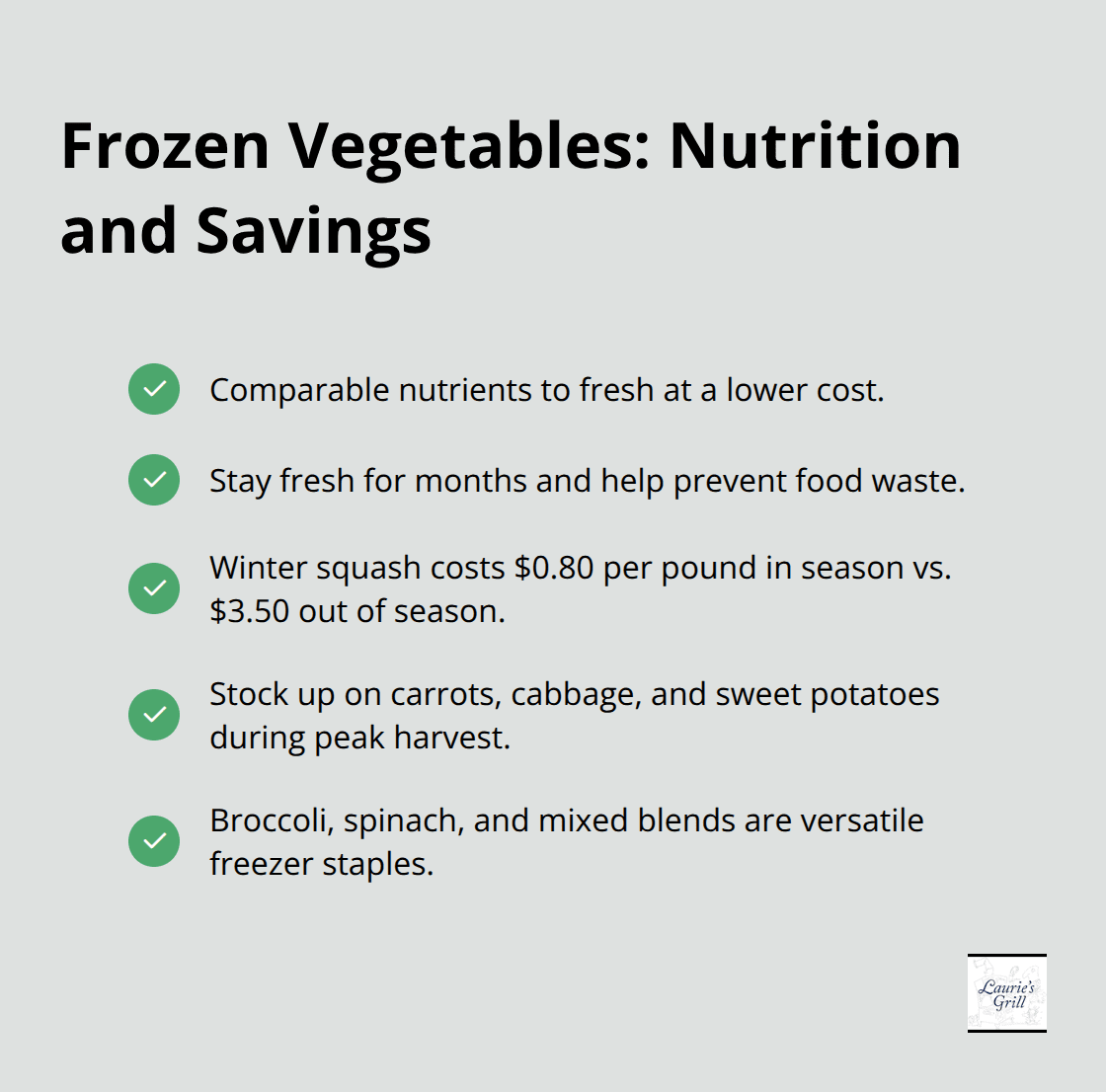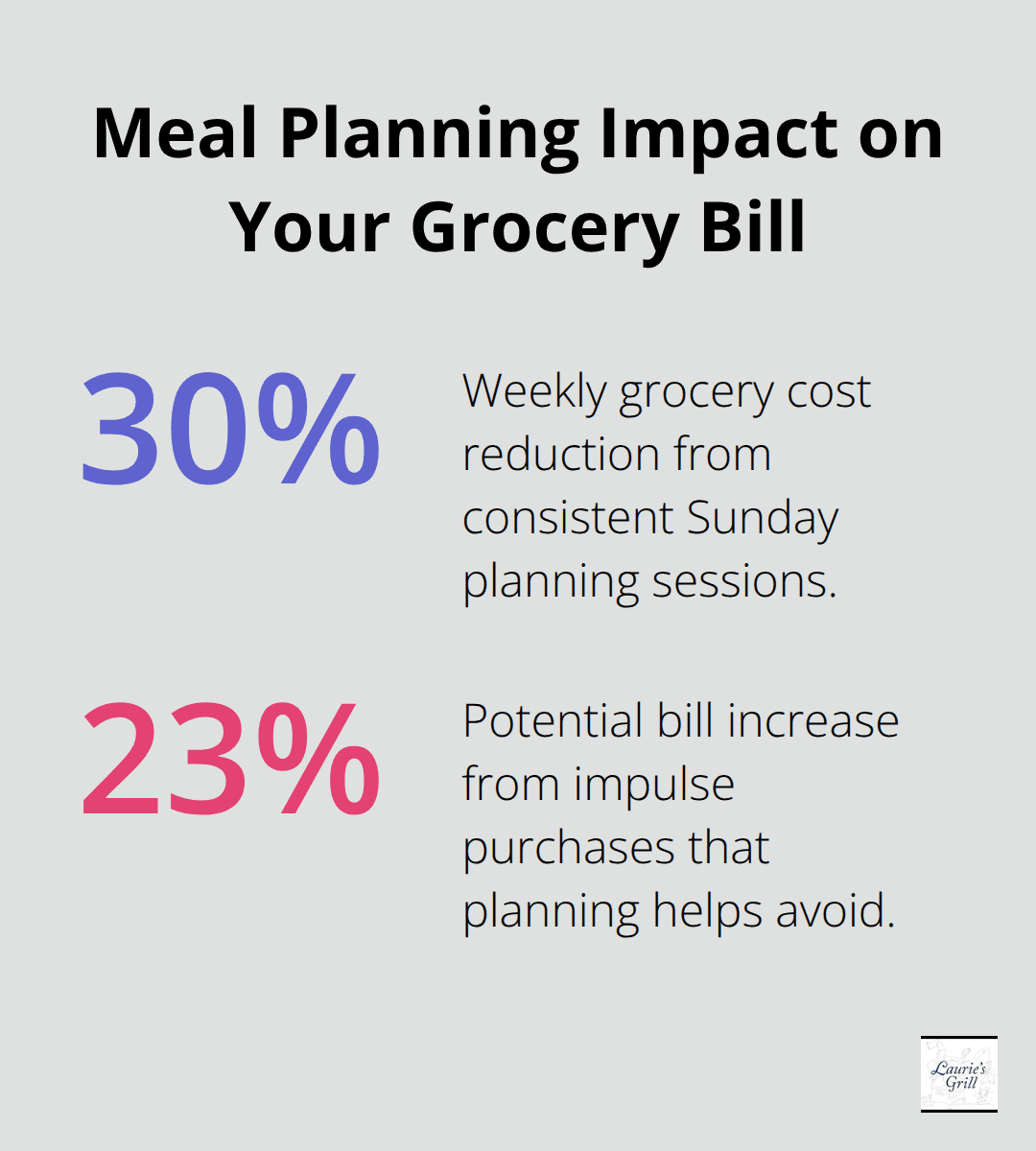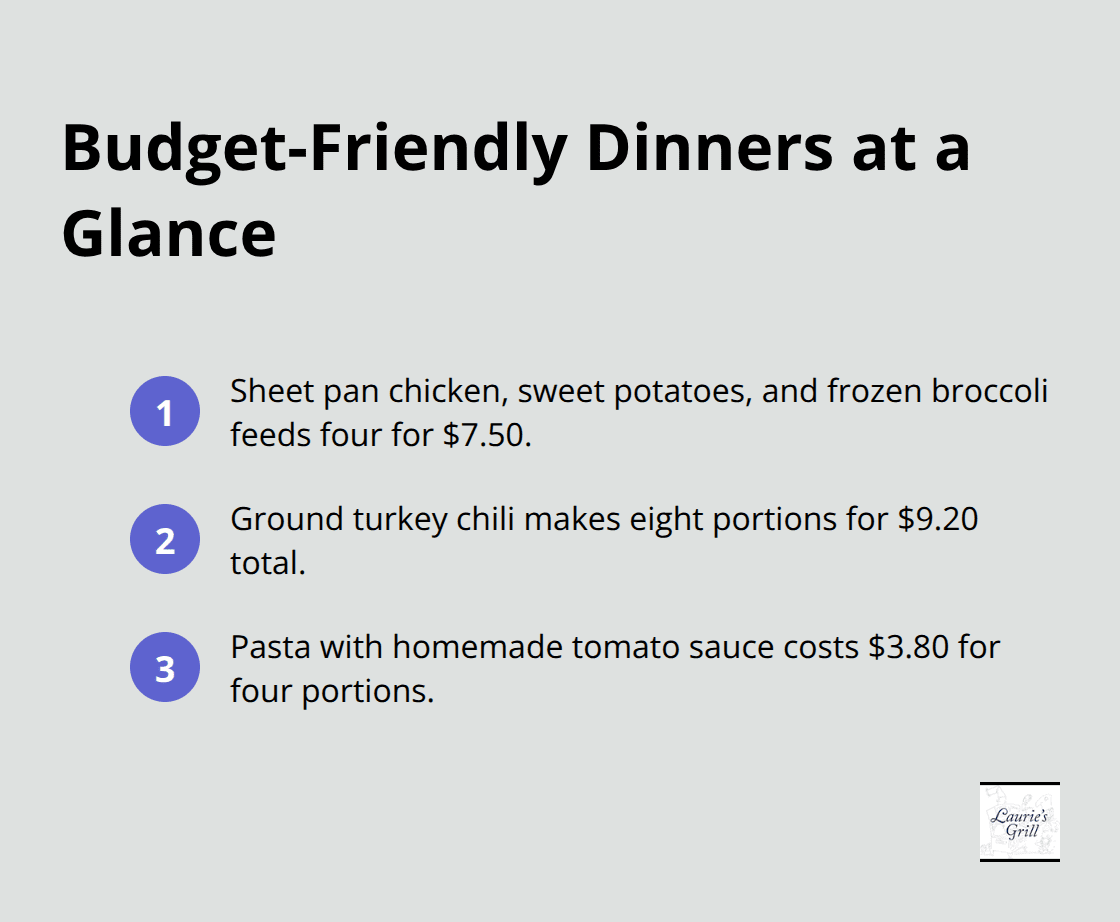Feeding your family nutritious food shouldn’t drain your wallet. The average American family spends $7,729 annually on groceries, yet 38% struggle to afford healthy options.
We at Laurie’s Grill believe affordable healthy family meals are possible with smart planning and the right ingredients. Simple strategies can cut your grocery bill by 25% while improving your family’s nutrition.
Which Ingredients Deliver Maximum Nutrition for Your Dollar
Frozen Vegetables Pack Nutrition and Value
Frozen vegetables offer the best bang for your buck when you feed a family healthy meals. Research shows frozen vegetables maintain comparable nutrient levels to fresh options while costing significantly less. Broccoli, spinach, and mixed vegetable blends stay fresh for months and eliminate food waste. Seasonal produce like winter squash costs just $0.80 per pound compared to $3.50 for out-of-season alternatives.

Stock up on carrots, cabbage, and sweet potatoes during peak harvest months to maximize your savings.
Whole Grains That Stretch Your Budget
Brown rice provides complete nutrition at $1.20 per pound and feeds a family of four for under $2 per meal. Oats cost just $0.03 per portion and create satisfying breakfasts that keep kids full until lunch. Quinoa delivers all nine essential amino acids for $4 per pound, which makes it cheaper than most meat proteins. These grains store for up to two years in airtight containers (this reduces your shopping trips and impulse purchases).
Smart Protein Choices That Save Money
Dried beans cost 75% less than canned varieties and provide 15 grams of protein per half-cup portion. Black beans, lentils, and chickpeas cook in large batches and freeze perfectly for quick weeknight meals. Eggs deliver high-quality protein for $0.20 each while chicken thighs cost $2 per pound versus $5 for chicken breasts. Harvard School of Public Health research shows plant proteins offer significant health benefits compared to meat-heavy meal plans while they provide superior fiber and nutrients.
Pantry Staples That Create Endless Possibilities
Canned tomatoes ($0.89 per can) form the base for pasta sauces, soups, and stews that feed your entire family. Olive oil and basic spices (salt, pepper, garlic powder) transform simple ingredients into flavorful meals without expensive sauces or seasonings. Whole wheat pasta costs $1.25 per box and pairs with any protein or vegetable combination you have on hand.
These budget-friendly ingredients become the foundation for meal plans that save both time and money throughout your week.
How Do You Plan Meals That Save Both Money and Time
Sunday Sessions Cut Weekly Grocery Costs by 30%
Successful families spend 30 minutes every Sunday and map their upcoming week’s meals around store sales and existing pantry items. The average American family of four loses $1,500 annually to uneaten food, making meal planning essential for budget control. Write down three breakfast options, five lunch ideas, and seven dinner choices that use overlapping ingredients like chicken, rice, and frozen vegetables.

Check your local grocery store’s weekly flyer before you plan and build meals around discounted proteins and produce. This strategy prevents impulse purchases that increase your grocery bill by 23% according to Food Marketing Institute data.
Batch Preparation Transforms Sunday Into Your Money-Saver
Cook large quantities of two base ingredients every Sunday: one protein and one grain that will anchor multiple meals throughout the week. Prepare four pounds of chicken thighs and three cups of brown rice to create chicken and rice bowls, chicken soup, and chicken quesadillas. Cook two pounds of ground turkey and a large pot of quinoa for turkey chili, turkey meatballs, and stuffed peppers. Smart menu planning helps reduce food waste while cutting costs. Portion cooked proteins into meal-sized containers and freeze half for the following week to avoid kitchen fatigue.
Smart Store Tactics Eliminate Food Waste and Overspending
Shop with a detailed list that follows store layout and stick to it religiously to avoid the average American’s $1,300 annual food waste. Purchase versatile ingredients that work in multiple recipes rather than single-use specialty items that expire unused. Choose chicken thighs over breasts, canned tomatoes over fresh, and frozen vegetables over fresh to maximize shelf life and minimize spoilage. Cornell University studies show perimeter-first routes keep you focused on whole foods while they help you avoid processed center-aisle temptations that inflate your bill.
Storage Systems That Maximize Your Investment
Label all containers with contents and dates to track freshness and prevent duplicate purchases (this simple step saves families $200 annually). Store grains in airtight containers to extend shelf life from months to years while you protect your bulk purchases from pests and moisture. Freeze proteins in meal-sized portions immediately after purchase to maintain quality and prevent freezer burn that wastes your investment.
These systematic approaches to meal preparation create the foundation for simple, affordable recipes that your family will actually eat.
What Are the Cheapest Healthy Recipes That Actually Work
One-Pot Meals That Feed Four for Under Five Dollars
One-pot meals eliminate expensive cleanup time while they maximize flavor from budget ingredients. Cook two cups of brown rice with four cups of chicken broth, one pound of chicken thighs, and two cups of frozen mixed vegetables for a complete meal that costs $4.20 total. The USDA confirms this combination provides all essential nutrients for balanced family nutrition. Add canned diced tomatoes and basic seasonings to create different flavor profiles throughout the week without you need to purchase additional ingredients.
Lentil and vegetable stew uses one cup of dried lentils, three cups of seasonal vegetables, and vegetable broth to feed four people for $3.50 while it delivers 18 grams of protein per serving. These meals cook in thirty minutes and create enough leftovers for lunch the next day.
Breakfast Solutions That Cost Less Than Fifty Cents Per Person
Overnight oats eliminate stress on busy mornings while they provide sustained energy for school and work days. Mix one cup of rolled oats with one cup of milk and sliced bananas to create four portions for $1.80 total. Research shows oats reduce hunger compared to sugary cereals that create energy crashes.
Scrambled eggs with leftover vegetables wrapped in whole wheat tortillas cost $2.40 for four breakfast burritos that freeze perfectly for busy mornings. Homemade pancakes use basic pantry ingredients (flour, eggs, milk) to feed your entire family for under $2 while store-bought frozen options cost $6 for the same quantity.
Dinner Plans That Prove Ten Dollars Feeds Everyone Well
Sheet pan meals maximize nutrition while they minimize cost and cleanup time for busy families. Roast chicken thighs with sweet potatoes and frozen broccoli for $7.50 to feed four people with enough leftovers for lunch the next day.

This method requires just fifteen minutes of prep time and cooks everything together.
Ground turkey chili uses one pound of turkey, two cans of beans, and canned tomatoes to create eight portions for $9.20 total. Pasta with homemade tomato sauce costs $3.80 for four generous portions when you use whole wheat noodles, canned tomatoes, and frozen vegetables instead of expensive pre-made sauces.
Final Thoughts
These proven strategies transform affordable healthy family meals from challenge to routine. Smart choices like frozen vegetables, whole grains, and budget proteins slash grocery costs by 25% while they boost nutrition. Weekly meal plans prevent the $1,500 annual food waste that drains family budgets.
Your family gains immediate benefits from home preparation: better nutrition, stronger immune systems, and reduced healthcare costs. Children who eat home-prepared meals show improved academic performance and develop lifelong healthy habits. Long-term savings compound as you avoid expensive processed foods and restaurant meals (these costs add up faster than most families realize).
Start with one strategy this week and plan three meals with ingredients you already own. We at Laurie’s Grill know that quality home-style meals bring families together. When you want a break from the kitchen, visit Laurie’s Grill for classic American comfort food that fits your budget. Small changes create lasting impact for your family’s health and financial future.


Recent Comments